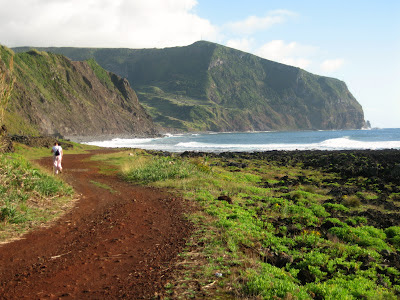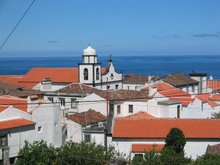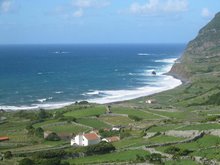Nowadays, if you want to get to the Azores, you have to go in a boring old Airbus A320 like every other European destination.
Between them, the Portuguese national airline TAP Portugal and the Azores airline SATA have about four or five flights a day from Lisbon to three of the larger islands (Sao Miguel, Terceira and Faial). From these three, you can then fly on to any of the other six islands the same day on a SATA Bombardier Dash 8-Q400, the regional propliner of choice:-
Thus, you can get to Flores from Lisbon in less than 6 hours. But it was different 50 years ago (which, I would remind people of my age, is as recently as the 1960s) when you had to go to the Azores on a ship - slower but a lot more fun.
The shipping company was called
Empresa Insulana de Navegção ("Island Shipping Company") and it served the Azores and Madeira from Lisbon in the days before mass air travel. In 1961, EIN made its last big investment in passenger ships by commissioning two new vessels.
The first - pictured above - was called
Funchal (after the capital of Madeira). Built at the Elsinore Shipyard in Denmark and carrying 400 passengers at 20 knots (23mph/37kmh), she sailed from Lisbon to Madeira and the larger islands of the Azores. She was the equivalent of today's TAP and SATA Airbuses except the journey by sea took two days instead two hours by air nowadays.
The other new ship of 1961 was a mini version of the
Funchal called
Ponta Delgada (named after the capital of the Azores). Her role was to take passengers out to the smaller islands of the Azores and thus she was the equivalent of today's SATA Q400s.
That's a classic picture of the
Ponta Delgada lying off Fajã Grande in the 1960s. There was no pier a ship could lie alongside at Flores before the 1990s so passengers had to be ferried out in a small launch as you can see here. (I assumed the ships lay off Santa Cruz on the east coast of Flores but perhaps they made additional calls round the island or maybe there was some reason why the PD could not call at SC that day.) The picture above is one of a very interesting series of old photos of Fajã Grande you can see on
Facebook (I hope that link works but as I'm not much of Facebooker, I'm not sure.)
Air travel gradually replaced these ships in the 70s and 80s. First to go were the
Funchal's services from Lisbon which ceased in 1973. She was converted that year to a cruise liner and, in fact, is still sailing in that role, still under the Portuguese flag - a remarkable achievement for a 50 year old ship.
That picture of the view from the
Funchal's bridge is from
Bruce Peter's blog where you can find lots of other pictures of her. And if you fancy a cruise amongst 60s Scandinavian decor, here's the link to her owners -
Classic International Cruises. It looks all very spit and polish and you get the distinct impression the captain of a CIC ship wouldn't be careless enough to bang his vessel into a bit of the scenery. And if he did, that he'd have the decency to hang around and face the music rather scarper on the first available lifeboat. (I'm at risk of digressing into stereotypical Italian cowardice but they really do ask for it, don't they? As if Berlusconi wasn't enough of a role model, they had to invent
Francesco Schettino just to ram the point home.)
 |
| Which lifeboat is the captain on? |
Anyway, wrenching myself back on topic (somewhat reluctantly), the
Ponta Delgada's career amongst the Azores lasted longer as not all the smaller islands had airports until the 1980s.
Regular "commenter" on this blog, Marisa Perreira, is from Graciosa but as a child in the 1970s she travelled to Flores most years to spend the summer with her grandmother in Fajã Grande. As there was no airport on Graciosa until 1981, that involved a sail on the
Ponta Delgada which began with being taken out to the ship in a launch as Graciosa didn't boast a pier in the 70s either.
In the course of a 24 hour voyage calling at São Jorge, Pico and Faial, Marisa's main memory of the Ponta Delgada is that it smelt of diesel and rocked "like a cot" - an idiom which doesn't exist in English although we know what's meant!
But at least she didn't suffer from sea-sickness like her sister who didn't emerge from the cabin for the whole voyage. Marisa used to wander off round the ship and one particular memory is of leaning in through a hatch cover on the foredeck chatting to crewmen below when the tannoy announced "If anyone has seen a curly haired little girl ..." On being reunited, her mother informed her that the crew were apt to throw naughty children overboard!
Landing at the Porto das Poças in Santa Cruz das Flores by launch from the Ponta Delgada lying off (as the pier at Lajes hadn't yet been built), Marisa recalls that what the sea journey didn't do to her, the journey in the back of Albino's truck weaving its way across the island to Fajã Grande did! The only cure was Grandma's
canjinha which in Marisa's words is "
home made chicken soup with the little eggs that were still inside the chicken". (Apparently there isn't a Portuguese word for these "little eggs" and there isn't an English one either, as far as I'm aware. If anyone knows different, leave a comment.)
The Ponta Delgada made her last leisurely sail round the Azores in October 1984. Finally rendered redundant by the relentless march of the aeroplane, she also took up a career as a cruise ship but by the late 90s her owners had gone bankrupt and she was lying abandoned at a remote quay in Lisbon, in an increasing state of decay and literally sinking fast:-
In 2008, the Lisbon Port Authority ordered the removal of the wreckage. There are lots more fascinating photographs of the Ponta Delgada - in life and death - on Luis Miguel Correia's blog .
So, today, people come to Flores on the plane and "stuff" comes on the container ship once a fortnight. In the summer, there's a rather infrequent (once a week at most) ferry service subsidised by the Azorean Government. If it were up to me, I'd sooner they spent the money on lights at the airport that would allow SATA's planes to land after dark in winter.

























